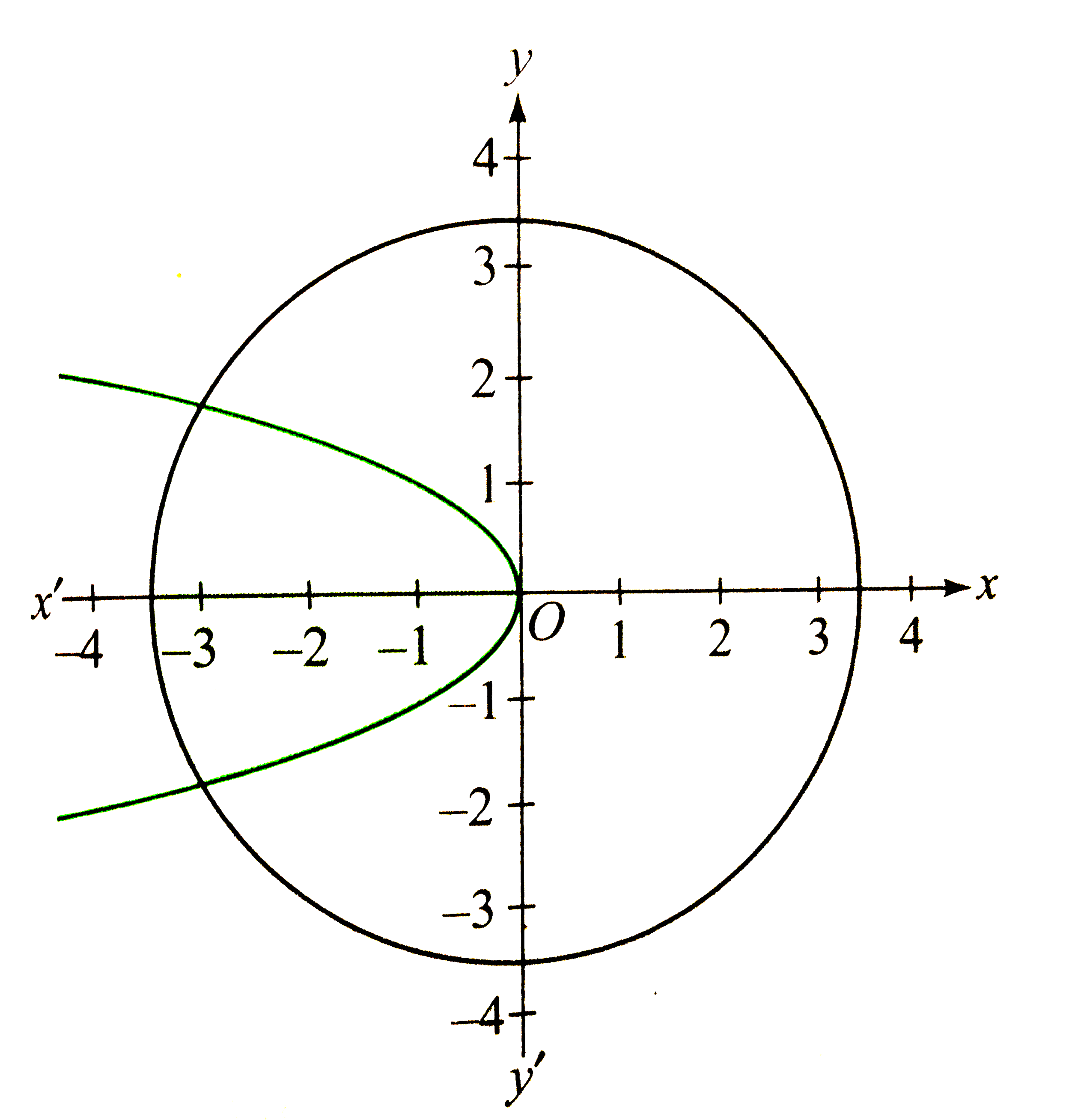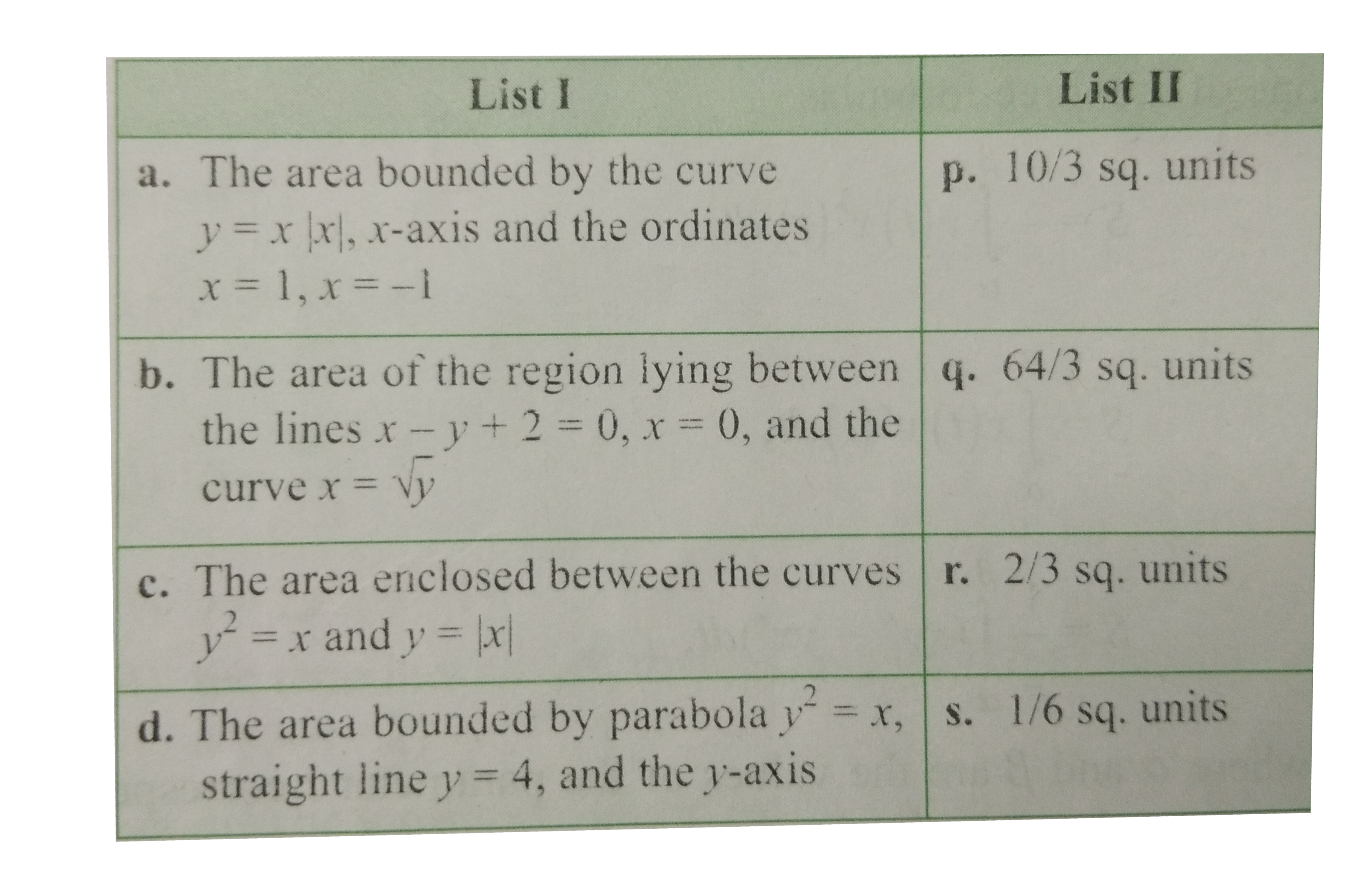Two curves satisfying the relation
The area bounded by the curve isSolution in Bengali
(a) sq. units
(b) sq. units
(c) sq. units
(d) sq. units
The correct Answer is:B
Given
Now equations of given curves are

Solving equations (1) and (2), we get
The area bounded by curves
sq. units.
Topper's Solved these Questions
- AREABOOK - CENGAGE PUBLICATIONCHAPTER - AREAEXERCISE - Matrix Match Type
5 Videos
- AREABOOK - CENGAGE PUBLICATIONCHAPTER - AREAEXERCISE - Numerical Value Type
18 Videos
- AREABOOK - CENGAGE PUBLICATIONCHAPTER - AREAEXERCISE - Multiple Correct Answers Type
13 Videos
- APPLICATIONS OF DERIVATIVESBOOK - CENGAGE PUBLICATIONCHAPTER - APPLICATIONS OF DERIVATIVESEXERCISE - Subjective Type
2 Videos
- BINOMIAL THEOREMBOOK - CENGAGE PUBLICATIONCHAPTER - BINOMIAL THEOREMEXERCISE - Comprehension
11 Videos
Similar Questions
Match the following lists :

View SolutionThe area enclosed by the curve c:y=x√9−x2(x≥0) and the x-axis is________
View SolutionLet A(k) be the area bounded by the curves y=x2−3 and y=kx+2 The range of A(k) is (10√53,∞) The range of A(k) is (20√53,∞) If function k→A(k) is defined for k∈[−2,∞ ), then A(k) is many-one function. The value of k for which area is minimum is 1.
View SolutionProve that for λ>1, the equation xlogx+x=λ has least one solution in [1,λ].
View SolutionConsider a G.P. with first term (1+x)n, |x|<1, common ratio 1+x2 and number of terms (n+1). Let 'S' be sum of all the terms of the G.P., then
The coefficient of xn is 'S' is
View SolutionIf a function satisfies (x−y)f(x+y)−(x+y)f(x−y)=2(x2y−y3)∀x,y∈Randf(1)=2, then
View SolutionIf a curve y=f(x) satisfies y''x^(2)+x(y')^(2)=2xy',f(0)=0 and f'(1)=1 then f(x) is
View SolutionTwo curves C1≡[f(y)]2/3+[f(x)]1/3=0andC2≡[f(y)]2/3+[f(x)]2/3=12, satisfying the relation (x−y)f(x+y)−(x+y)f(x−y)=4xy(x2−y2)
The area bounded by C1andC2 is
View SolutionTwo curves C1≡[f(y)]2/3+[f(x)]1/3=0andC2≡[f(y)]2/3+[f(x)]2/3=12, satisfying the relation (x−y)f(x+y)−(x+y)f(x−y)=4xy(x2−y2)
The area bounded by the curve C2and|x|+|y|=√12 is
View SolutionTwo curves C1≡[f(y)]2/3+[f(x)]1/3=0andC2≡[f(y)]2/3+[f(x)]2/3=12, satisfying the relation (x−y)f(x+y)−(x+y)f(x−y)=4xy(x2−y2)
The area bounded by C1andx+y+2=0 is
View SolutionEvaluate ∣∣ ∣∣.xC1.xC2.xC3.yC1.yC2.yC3.xC1.zC2.zC3∣∣ ∣∣
View SolutionIf C1≡y=11+x2andC2≡y=x22 be two curve lying in XY plane. Then
View SolutionTwo curves C1≡[f(y)]2/3+[f(x)]1/3=0andC2≡[f(y)]2/3+[f(x)]2/3=12, satisfying the relation (x−y)f(x+y)−(x+y)f(x−y)=4xy(x2−y2)
The area bounded by the curve C1andC2 is
View SolutionTwo curves C1≡[f(y)]2/3+[f(x)]1/3=0andC2≡[f(y)]2/3+[f(x)]2/3=12, satisfying the relation (x−y)f(x+y)−(x+y)f(x−y)=4xy(x2−y2)
The area bounded by the curve C2and|x|+|y|=√12 is
View SolutionTwo curves C1≡[f(y)]2/3+[f(x)]1/3=0andC2≡[f(y)]2/3+[f(x)]2/3=12, satisfying the relation (x−y)f(x+y)−(x+y)f(x−y)=4xy(x2−y2)
The area bounded by C1andx+y+2=0 is
View SolutionEvaluate ∣∣ ∣∣.xC1.xC2.xC3.yC1.yC2.yC3.xC1.zC2.zC3∣∣ ∣∣
View Solution
